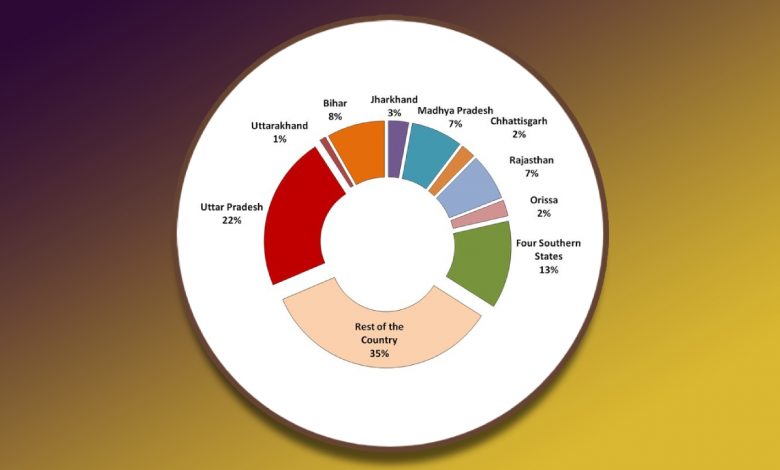Daily Current Affairs for UPSC
Stabilising population growth in India

Topic- Growth and Development [GS Paper-3]
Context- As the global population reached eight billion, the United Nations has recently said that India’s population growth appeared to be stabilising, which shows that the country’s national policies and health systems, including access to family planning services, are working.
Key Highlights
- The U.N. attributes the growth to human development, with people living longer as a result of the improvements in public health, nutrition, personal hygiene and medicine.
- It is also the result of higher fertility rates, particularly in the poorest countries of the world most of which are in sub-Saharan Africa putting their development goals at risk.
- Population growth has also enlarged the environmental impacts of economic development.
- However, considering eight billion humans are too many for planet Earth, most experts say the bigger problem is the overconsumption of resources by the wealthiest people.
- Also some experts express concerns that our world is overpopulated.
- The choices made by the population result in humans consuming far more biological resources, such as forests and land, than the planet can regenerate each year.
- The overconsumption of fossil fuels, for example, leads to more carbon dioxide emissions that stand responsible for global warming.
Statistics given by the U.N.
- The current global population is more than three times higher than the 2.5 billion global headcounts in 1950.
- However, after a peak in the early 1960s, the world’s population growth rate has decelerated dramatically.
- Annual population growth has fallen from a high of 2.1% between 1962 and 1965 to below 1% in 2020.
- The figure could potentially fall further to around 0.5% by 2050 due to a continued decline in fertility rates, the United Nations projects.
- The U.N. foresights the population to continue growing to about 8.5 billion in 2030, 9.7 billion in 2050 and peak around 10.4 billion in the 2080s.
Statistics given by other institutions
- The U.S.-based Institute for Health Metrics and Evaluation (IHME) has estimated in a 2020 study that the global population would max out by 2064, without ever reaching 10 billion, and decline to 8.8 billion by 2100.
- Since the emergence of the first humans in Africa more than two million years ago the world’s population has ballooned, with only fleeting pauses to the increasing number of people sharing Earth.
- Early humans were hunter-gatherers, who had few children compared to later settled populations in order to maintain their nomadic lifestyle.
- After the introduction of agriculture in the Neolithic era, around 10,000 BC, brought the first known major population leap.
- With agriculture came sedentarization and the ability to store food, which resulted birth rates to soar.
- According to the datas of a French Institute for Demographic Studies, from around six million in 10,000 BC, the global population leapt to 100 million in 2,000 BC and then to 250 million in the first century AD,
- Due to the Black Death, the human population dropped between 1300 and 1400, from 429 to 374 million.
- Other events, like the Plague of Justinian, which hit the Mediterranean over two centuries from 541-767, and the wars of the early Middle Ages in western Europe, also caused temporary decline in the number of humans on Earth.
- From the 19th century onwards, the population started to explode, due largely to the development of modern medicine and the industrialization of agriculture, which boosted global food supplies.
- Since 1800, the world’s population has increased eightfold, from an estimated one billion to eight billion.
- The development of vaccines was key, with the smallpox jab particularly helping zap, considered as one of history’s biggest killers.
India’s Scenario
- The world population touched eight billion recently and India was the largest contributor to the milestone, having added 177 million people of the last billion people born in the world, as per the U.N.
- However, India’s population growth appears to be stabilising.
- The Total Fertility Rate stands at more or less the average number of children born per woman which has declined from 2.2 to 2.0 at the national level, as per the United Nations Population Fund (UNFPA).
- A total of 31 States and Union Territories i.e. constituting 69.7% of the country’s population have achieved fertility rates below the replacement level of 2.1.
- The main reasons for the decline in fertility include increase in adoption of modern family planning methods (from 47.8% in 2015-16 to 56.5% in 2019-21) and a reduction in unmet need for family planning by four percentage points over the same period.
- It indicates significant improvements in access to family planning related information and services.
- The data also shows that India’s national population policies and health systems are well working.
- India is a youthful nation with the largest cohort of young people anywhere in the world, with major potential to achieve its demographic dividend.
- While many parts of the world are aging, India’s youthful population can be a global resource to solve global problems.
United Nations Population Fund
- The UNFPA is a subsidiary organ of the UN General Assembly and it works as a sexual and reproductive health agency.
- The UN Economic and Social Council (ECOSOC) establishes the mandate of the Fund.
- It was established as a trust fund in 1967 and began its operations in 1969.
- In 1987, the organisation was officially renamed the United Nations Population Fund but the original abbreviation, ‘UNFPA’ for the United Nations Fund for Population Activities was retained.
- UNFPA works with certain objectives such as to tackle Sustainable Development Goals on health (SDG3), education (SDG4) and gender equality (SDG5).
- UNFPA is not supported by the UN budget, rather it is entirely supported by voluntary contributions of donor governments, intergovernmental organizations, the private sector, foundations and individuals.





.png)



